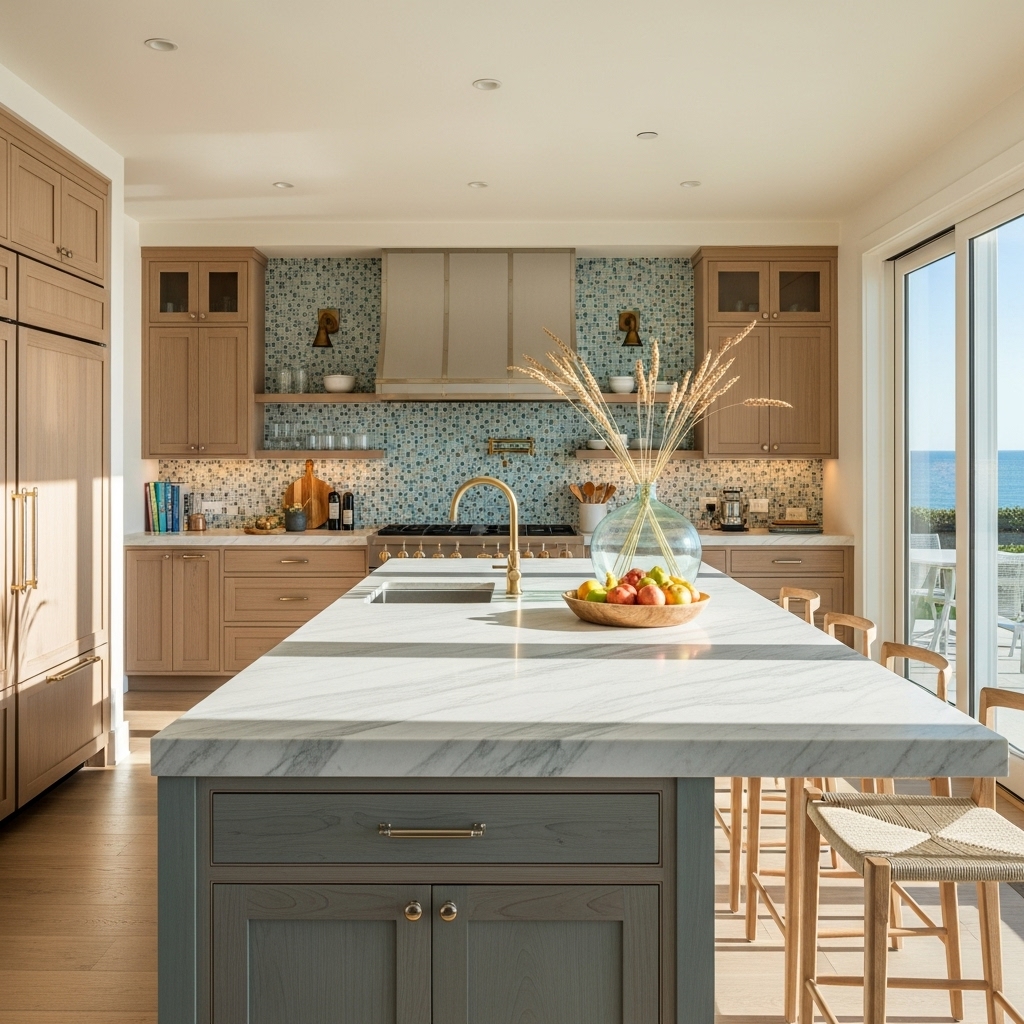Designing a Coastal-Ready Kitchen
A well-planned kitchen is the heart of a Huntington Beach home, where indoor comfort meets ocean breezes and sunlit gatherings. The best upgrades balance performance, durability, and beauty while respecting the realities of salt air and daily use. This guide walks through layout, ventilation, lighting, storage, surfaces, and technology so you can transform your kitchen with confidence. If you want a streamlined path from concept to cook-in date, explore how a coordinated home renovation process helps align drawings, material choices, and construction sequencing.
Start with how you cook and entertain, then translate habits into zones: prep, cook, cleanup, and serving. Plan clear circulation so more than one person can work comfortably. Consider sightlines to living areas and outdoor spaces, especially if you host often or keep an eye on kids and pets.
Layout Foundations: From Triangle to Task Zones
The classic work triangle still works, but modern kitchens benefit from task zones. A prep island with nearby water, a cooking zone with ventilation and landing space, and a cleanup zone with organized storage reduce steps. If you prefer back-of-house functionality, a pantry wall can hold small appliances and staple storage to keep counters clean.
Ventilation that Protects Your Investment
Ventilation is your first defense against moisture and grease. Choose a system sized for your cooking style and route ductwork efficiently to the exterior. In coastal settings, specify corrosion-resistant components and exterior caps designed for salt air. Quiet performance encourages daily use, preserving finishes and improving indoor air quality.
Lighting Layers that Elevate Everyday Tasks
Combine general illumination, task lighting, and accent light to create a kitchen that works from breakfast to midnight snacks. Recessed downlights provide even base light, under-cabinet fixtures brighten prep surfaces, and pendants add warmth and scale at the island. Keep color temperatures consistent across fixtures for a cohesive feel.
Cabinet Construction and Storage Strategies
Durable cabinet boxes and thoughtful hardware contribute more to daily satisfaction than ornate fronts. Soft-close hinges and full-extension glides improve function. Interior organizers—tray dividers, spice pullouts, and deep drawers—reduce clutter. In a coastal environment, finishes that resist moisture and UV exposure perform best, and sealed edges help cabinets keep their shape over time.
Countertops and Backsplashes Built for Daily Use
Surfaces should stand up to busy weeks and weekend gatherings. Choose countertops that balance durability with care needs you are comfortable adopting. Backsplash materials in high-splash areas protect walls while adding personality. Use easy-clean grout or larger tile formats to reduce maintenance in cooking zones.
Appliance Planning and Electrical Readiness
Plan dedicated circuits for appliances and consider future upgrades when sizing electrical service. Provide sufficient landing areas around appliances and power where you need it, including at islands for small appliances and charging. Well-placed outlets keep counters flexible without cluttering backsplashes.
Water, Filtration, and Coastal Durability
Protect fixtures and finishes with properly sized shutoffs, quality supply lines, and filtration appropriate for your preferences. In salt-air regions, corrosion-resistant finishes and components extend service life. Plan sink locations for ergonomic use—centered under windows or with views to living spaces—and consider prep sinks when multiple cooks share the space.
Flooring, Transitions, and Thresholds
Choose flooring that handles sandy feet and frequent cleanup. Seamless transitions to adjacent rooms support open plans. At patio doors, plan thresholds and mats that trap grit before it reaches the kitchen. For durability, select finishes that maintain traction when slightly wet.
Organization that Encourages Calm
A clutter-free kitchen comes from thoughtful storage. Vertical tray slots, pullout pantries, corner solutions, and drawer dividers keep tools accessible. Consider a small appliance garage to keep counters open while still convenient. Designated recycling and compost zones make daily routines smoother.
Details that Define Quality
Quality reveals itself in edges and alignments: consistent reveals around panels, level crown molding, and clean terminations at backsplashes. Plan scribe pieces at walls to accommodate minor irregularities. Confirm handle placement and appliance panel gaps in the drawings to avoid field improvisation.
Indoor-Outdoor Connection
A Huntington Beach kitchen often spills outdoors. Align island and dining orientations with sliding or folding doors and plan covered seating for shade. Weather-resistant surfaces near openings handle occasional spray or damp air, and well-detailed thresholds protect flooring.
Technology and Smart Controls
Scene-capable lighting, occupancy sensors in the pantry, and integrated speakers make kitchens more adaptable. Place charging drawers or dedicated outlets where devices live to reduce clutter. If you use smart appliances, plan network coverage and low-voltage pathways early.
Construction Sequencing and Site Protection
Coordinate rough-ins, flooring, and cabinet install dates so templating and appliance deliveries land smoothly. Protect finished floors and set a clean, closed room for cabinet staging. A tidy site reduces damage risk and keeps the team efficient.
Kitchen Upgrade Checklist
- Define zones and circulation patterns.
- Confirm ventilation type and route to exterior.
- Plan lighting layers and consistent color temperatures.
- Specify cabinet construction, hardware, and organizers.
- Choose durable, easy-care countertops and backsplash materials.
- Provide dedicated appliance circuits and island power.
- Incorporate filtration and corrosion-resistant fixtures.
- Select resilient flooring and plan clean transitions.
- Design storage for everyday calm and easy access.
- Integrate technology and plan low-voltage routes.
- Prepare for permitting, inspections, and scheduling.
- Stage delivery, protect finishes, and maintain site order.
Frequently Asked Questions
Q: How do I choose the right ventilation? A: Match the system to your cooking habits and route ducts efficiently. In coastal areas, use corrosion-resistant components and exterior caps.
Q: Can I add an island in a smaller kitchen? A: Yes, if circulation remains clear. Consider a slim island with storage and power to maximize utility without crowding.
Q: What cabinet features improve daily function most? A: Full-extension drawers, soft-close hardware, and interior organizers deliver everyday benefits without visual clutter.
Q: Are there coastal finishes I should favor? A: Moisture-tolerant cabinet finishes, sealed edges, and hardware designed for salty air improve longevity.
Q: How can lighting make a big difference? A: Layered lighting improves visibility and ambiance. Keep color temperatures consistent so materials look their best.
Q: What should I plan for during construction? A: Early coordination of rough-ins and protection of finished materials keep the schedule steady and the kitchen pristine at turnover.
Bring Your Kitchen Vision to Life
The most successful kitchens unite thoughtful layout, durable materials, and clean details that perform day after day. When you are ready to elevate your Huntington Beach home, choose a partner who can guide design, permitting, and construction from a single point of accountability. Explore a proven path for a coastal-ready home renovation that delivers beauty and function in equal measure.

